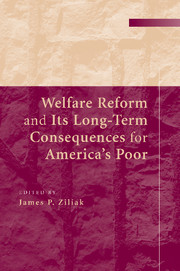Book contents
- Frontmatter
- Contents
- Contributors
- Preface
- Introduction
- 1 What We Know, What We Don't Know, and What We Need to Know about Welfare Reform
- 2 Welfare Reform and the Level and Composition of Income
- 3 How Have Expansions in the Earned Income Tax Credit Affected Family Expenditures?
- 4 How Families Are Doing Nine Years after Welfare Reform: 2005 Evidence from the Three-City Study
- 5 The Impact of Welfare Reform on Leaver Characteristics, Employment, and Recidivism
- 6 A Reexamination of the Impact of Welfare Reform on Health Insurance Among Less-Skilled Women
- 7 How Welfare Policies Affect Child and Adolescent School Performance: Investigating Pathways of Influence with Experimental Data
- 8 The Effects of Welfare and Child Support Policies on the Incidence of Marriage Following a Nonmarital Birth
- 9 Welfare Reform and Health among the Children of Immigrants
- 10 Mismatches and Unmet Need: Access to Social Services in Urban and Rural America
- Index
8 - The Effects of Welfare and Child Support Policies on the Incidence of Marriage Following a Nonmarital Birth
Published online by Cambridge University Press: 21 January 2010
- Frontmatter
- Contents
- Contributors
- Preface
- Introduction
- 1 What We Know, What We Don't Know, and What We Need to Know about Welfare Reform
- 2 Welfare Reform and the Level and Composition of Income
- 3 How Have Expansions in the Earned Income Tax Credit Affected Family Expenditures?
- 4 How Families Are Doing Nine Years after Welfare Reform: 2005 Evidence from the Three-City Study
- 5 The Impact of Welfare Reform on Leaver Characteristics, Employment, and Recidivism
- 6 A Reexamination of the Impact of Welfare Reform on Health Insurance Among Less-Skilled Women
- 7 How Welfare Policies Affect Child and Adolescent School Performance: Investigating Pathways of Influence with Experimental Data
- 8 The Effects of Welfare and Child Support Policies on the Incidence of Marriage Following a Nonmarital Birth
- 9 Welfare Reform and Health among the Children of Immigrants
- 10 Mismatches and Unmet Need: Access to Social Services in Urban and Rural America
- Index
Summary
Introduction
Researchers and policymakers have long been concerned that government policies may influence individual behavior in unintended ways. In particular, they worry that by providing mothers with an income that is independent of marriage, welfare and child support policies may discourage marriage and increase union dissolution. Economic theory is clear with respect to the marriage disincentives of welfare for single mothers (Becker 1981), but it is ambiguous with respect to the potential effects of child support policies on marriage. Whereas stronger child support enforcement reduces the costs of single motherhood for women, making marriage less attractive, it increases the costs for fathers, making marriage more attractive. Which effect dominates is an empirical question. Although empirical studies vary with respect to effect size and methods, the evidence compiled during the 1980s and early 1990s indicates that welfare generosity during this period had a small negative effect on marriage among mothers (Moffitt 1998), whereas stronger child support enforcement reduced single motherhood by reducing nonmarital childbearing (Aizer and McLanahan 2006; Case 1998; see Nixon 1997 for different findings; Plotnick et al. 2004), though few researchers have pulled apart the decisions to give birth and to marry given a nonmarital conception.
In 1996, the Personal Responsibility and Work Opportunities Reconciliation Act (PRWORA) changed the parameters of welfare receipt and strengthened child support enforcement. Although under the new welfare regime states continued to provide modest cash benefits to poor single mothers, benefits are now constrained by time limits and work requirements that increase the costs of being a single mother relative to being a married mother.
- Type
- Chapter
- Information
- Welfare Reform and its Long-Term Consequences for America's Poor , pp. 290 - 307Publisher: Cambridge University PressPrint publication year: 2009
- 3
- Cited by

